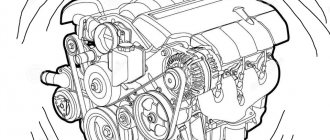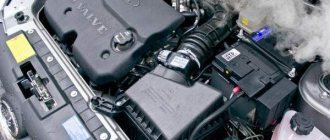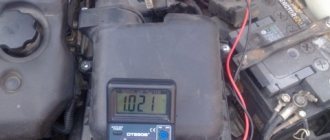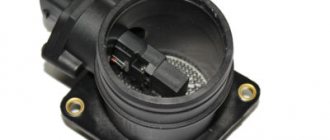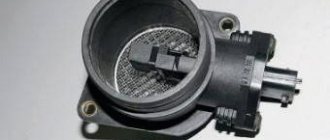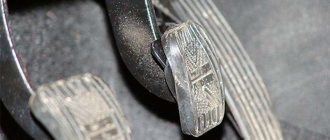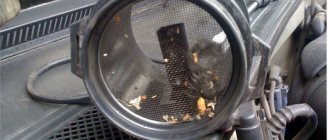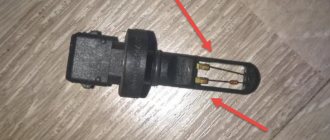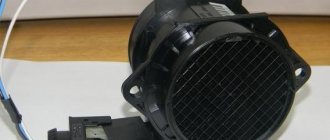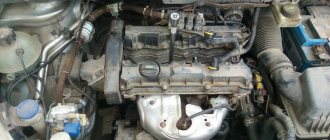Reliable operation of a car engine is achieved through the correct operation of all internal combustion engine components. The VAZ 2114 is equipped with an injection engine, which is demanding on the frequency of the system and its tightness. The slightest deviations from the permissible values lead the engine to emergency operation. In order for the engine to operate correctly, it is necessary to carefully monitor the tightness of the intake system.
All air entering the engine must be taken into account by the air flow sensor, but it happens that unwanted air leaks appear in the car, which lead to unstable operation of the engine in all its operating modes.
This article talks about how air leaks affect the operation of the VAZ 2114 engine, as well as ways to find and eliminate it. It is quite difficult to find the air leak on your own, but after studying our article, you can easily find the unfortunate place where the system is depressurized.
How does air leakage affect the operation of the internal combustion engine?
For reliable operation of the internal combustion engine, a sealed air intake system is needed. This is necessary for accurate preparation of the fuel mixture. The engine control unit prepares the air-fuel mixture based on the readings of the mass air flow sensor (MAF). The air passing through the mass air flow sensor is counted and transmitted to the control unit, which sends a signal to the injectors and opens them and keeps them open until the required amount of fuel is supplied to create the correct mixture. This operation of the internal combustion engine is correct, but when unwanted air leaks appear in the engine after the mass air flow sensor, its volume increases.
It turns out that the air flow sensor transmitted readings to the ECU about the same amount of air passing through it, but in fact, due to suction, the air volume is much larger than it should be, but the ECU does not know about it. Because of this, the fuel mixture is formed incorrectly.
Signs of air leaks
Incorrect formation of the fuel mixture leads to unstable operation of the internal combustion engine and with this problem the following symptoms are observed:
- Difficulty starting the engine when cold after a long period of inactivity;
- Unstable idling, speed jumps from 500 to 2000 rpm are observed;
- Increased engine vibration at idle;
- Loss of power and former dynamics of the car; to accelerate the car you need to press harder on the gas pedal;
- Fuel consumption increases;
These signs indicate a problem with the vehicle and require a quick solution to the problem. It should be noted that these symptoms can arise for other reasons, but checking the engine for air leaks is one of the number one points in solving problems in the operation of the internal combustion engine.
List of main reasons
Reasons why idle speed fluctuates
Incorrect operation of the power unit may be caused by a malfunction of certain elements:
- Failure of sensors:
- RXX;
- DMRV;
- DPKV;
- Lambda probe;
- DSA.
- The XX solenoid valve is faulty;
- The air filter is clogged;
- Heavy carbon deposits on candles;
- High-voltage wires are damaged or oxidized;
- Air leak in the intake manifold;
- Incorrect throttle position.
Places where there may be suction
Air leakage can be anywhere where it passes to the combustion chamber, be it the intake corrugation or the receiver. There are several places where system depressurization occurs quite often.
Places of possible suction:
- Joints of the corrugation with the sensor and throttle assembly;
- Idle air control;
- Small breather;
- Vacuum brake booster;
- Absorber tubes;
- Injector rings;
- Intake receiver gaskets;
All of the above places are prone to air leaks in the VAZ 2114 system and if leaks are suspected, it is necessary to inspect these particular suspicious places.
Briefly about each place
Corrugated joints
The corrugation is connected to the throttle assembly and the mass air flow sensor through a clamp; sometimes this clamp may not provide reliable tightening, which leads to suction.
RXX
The idle air control is installed in the remote control through an o-ring, which ensures the tightness of the system. Often this ring loses its properties and begins to let air through.
It should be noted that the IAC is installed only on cars with a mechanical throttle.
Breather
The small breather communicates with the intake corrugation through a clamp; relaxation of this clamp leads to possible air leakage in front of the throttle assembly.
VUT
The vacuum brake booster is connected to the intake receiver through a special hose, which can become damaged and begin to let in unwanted air; also in the VUT, the membrane and intake fitting are often damaged, which leads to air leaks through the brake booster.
Injector rings
To seal the junction of the injectors with the cylinder head, special rubber rings are used, which ensure reliable tightness of the system and prevent its depressurization. Due to high temperatures, rubber rings tend to lose their elasticity and become rigid, which leads to air leakage through them.
Receiver seals
The plastic receiver is connected to the cylinder head through rubber sealing rings that adhere to the surface of the head. Due to high temperatures, they lose their properties and begin to let in excess air.
Checking the internal combustion engine for air leaks
To make sure there is an air leak in the engine, there is no need to go to a service station and pay a tidy sum. You can check the presence of air leaks yourself.
- To do this, unscrew the mass air flow sensor from the air filter box and remove it.
- Next, start the car and close the inlet with your hand or some other object.
- With a sealed system, the engine should stall and the intake corrugation should compress and remain in a compressed position for several seconds.
If the car does not stall or stalls, but the corrugation does not compress, then most likely there is an air leak in the car and you need to start looking for it.
Lada 2109 The greenest amulet › Logbook › Check the tightness of the injectors.
I recently cleaned the nozzle myself. I took it out and connected it to the battery through a light bulb. For cleaning I used ABRO carburetor cleaner. The nozzles were blown out with a not very good burner. After some time it went away. My car consumes a lot of gasoline, but I thought that everything was fine with the injectors, since they didn’t miss them during cleaning. Also sausage on my knees. So I unscrewed the spark plugs to see what they looked like. Then a surprise awaited me. The 3 cylinder cap was filled with gasoline, as if you had dipped it into the gas tank. The rest of the candles are like nothing else. A couple of days later I unscrewed the spark plugs of cylinders 3 and 4 (I didn’t do the rest, I didn’t have time), and again 3 gasoline spark plugs. Some time passed, I unscrewed the third spark plug and it dried up... What an epst. I twisted it for a couple more days, it was always dry. BUT! I won't let my typewriter live like this???? I will rape you until she earns like a Murzillian. I decided to gather my strength and check the injectors for leaks. I removed the air filter and receiver tube. UNDER-END removed the screw so I could remove the fuel lines from the bracket, I bent them.
He unscrewed the fuel rail screws, turned the injectors toward him so he could see the injectors, and used a screwdriver to secure it in that position.
He dried each nozzle.
1 nozzle (DO)
2 nozzles (DO)
3 nozzles (DO)
4 nozzles (DO)
I connected the pressure gauge from the pump to the fuel rail to see the pressure but couldn't find the clamp so I lost it a bit so the pressure can be ignored but it dropped; I turned the key to the on position so that the pump pumped gasoline into the fuel rail. And immediately, IMMEDIATELY I saw that all the injectors began to leak gasoline, and a lot of it... Then I realized that I had hit the injectors.
1 and 2 injectors (after)
3 nozzles (after)
4 nozzles (after)
Now I’m thinking about how, what and where to order injectors so that they are more economical and normal. Having searched for information on the Internet, I came to the conclusion that the analogue of my injectors is BOSCH 0 280 158 110 (since they have not been produced for a long time). My analogue was the most expensive among other injectors from both BOSCH and SIEMENS. great.. Will have to save money???? Because I want everything to be fine with my car.
How to find the leak location
Air leaks can be found in several ways. The most popular method is a smoke generator, but if this is not available, then you can use a regular soap solution.
Using a smoke generator
A smoke generator is a device that produces a large amount of smoke. It is connected to the intake system, smoke spreads throughout the system and begins to seep out in places where there is no tightness.
Video
With pump and soap
Finding the place where air leaks occur without a smoke generator can be done using a soap solution.
To do this, prepare soapy water.
- Next, we close the mass air flow sensor with a plastic bag, namely, we put the bag on the sensor, then we put a clamp with corrugation on top.
- We connect a compressor or pump through the absorber fitting and pump pressure into the system.
- Then we water all suspicious areas with soapy water.
- In those places where there is air leakage, soap bubbles will begin to inflate.
How does the Lada Kalina gasoline vapor recovery system work?
The EVAP system in question was created to prevent the release of harmful gasoline vapors into the surrounding atmosphere resulting from fuel evaporation; it includes:
- fuel shut-off valve;
- adsorber;
- solenoid valve for purging the absorbent element;
- connecting pipelines.
The most important component in the system is the adsorber (also called a carbon filter), the basis of which is activated non-edible carbon, enclosed in a plastic housing. The resulting gasoline vapors are absorbed by the carbon of the absorbent element, gradually accumulating in it. When the engine starts, the canister purge valve (KPA) is turned on, and due to the vacuum, all accumulated vapors enter the intake manifold and then burn out.
On the Lada Kalina, the adsorber is located in the gas tank area, and getting to it is very difficult. To dismantle this EVAP element, it is necessary to remove the fuel tank, but the control unit is located in an accessible place - the valve is located in the engine compartment, in close proximity to the battery, on the rear wall of the air filter housing. It should be noted that for turbocharged engines, a vacuum is not created in the intake manifold, and in order to force the vapors in the desired direction, an additional two-way valve is included in the circuit.
